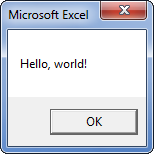Difference between revisions of "Creating our first button in VBA"
(→Code Analysis I) |
|||
| Line 41: | Line 41: | ||
== Code Analysis I == | == Code Analysis I == | ||
| − | <syntaxhighlight lang="vb"> | + | <syntaxhighlight lang="vb" line start="13"> |
' Add a new group to our tab | ' Add a new group to our tab | ||
With .groups.Add(New rxGroup) | With .groups.Add(New rxGroup) | ||
| Line 52: | Line 52: | ||
| − | <syntaxhighlight lang="vb"> | + | <syntaxhighlight lang="vb" line start="17"> |
' Add a new button to our group | ' Add a new button to our group | ||
With .Buttons.Add(New rxButton) | With .Buttons.Add(New rxButton) | ||
| Line 61: | Line 61: | ||
Each [[rxGroup]] object has a collection of [[rxButton]] objects (accesible through its .buttons property). Here we add a new button to out group's buttons and label it 'My Button' | Each [[rxGroup]] object has a collection of [[rxButton]] objects (accesible through its .buttons property). Here we add a new button to out group's buttons and label it 'My Button' | ||
| − | |||
== Adding a handler for the button's onAction delegate == | == Adding a handler for the button's onAction delegate == | ||
Revision as of 21:09, 10 March 2013
Contents
Prerequisites
We recommend you go though A 'hello world' VBA program before going into this example.
Creating a button
- Enter the code below in a standard VBA module
Public Sub CreateMyUI3()
Dim myCustomUI As rxCustomUI
Set myCustomUI = rxCustomUI.defaultInstanceWith myCustomUI' Clear old state.Clear
' Add a new tabWith .ribbon.tabs.Add(New rxTab)
.Label = "My First Tab"' Add a new group to our tabWith .groups.Add(New rxGroup)
.Label = "My Group"' Add a new button to our groupWith .Buttons.Add(New rxButton)
.Label = "My Button"End With
End With
End With
' Render the UI.Refresh
End With
End Sub
- Run the sub to create a button labeled 'My Button' (which belongs to a group labeled 'My Group' which, in turn' belongs to a tab labeled 'My Tab')
-
Code Analysis I
' Add a new group to our tabWith .groups.Add(New rxGroup)
.Label = "My Group"'...End With
Each rxTab object has a collection of rxGroup objects (accessible through its .groups property). Here we add a new group to our tab's groups and label it 'My Group'
' Add a new button to our groupWith .Buttons.Add(New rxButton)
.Label = "My Button"End With
Each rxGroup object has a collection of rxButton objects (accesible through its .buttons property). Here we add a new button to out group's buttons and label it 'My Button'
Adding a handler for the button's onAction delegate
At the moment the new button isn't of much use as it does nothing when clicked. In this section we will hook up to the control's onAction delegate.
- Update the sub as follows
Public Sub CreateMyUI3()
Dim myCustomUI As rxCustomUI
Set myCustomUI = rxCustomUI.defaultInstanceWith myCustomUI' Clear old state.Clear
' Add a new tabWith .ribbon.tabs.Add(New rxTab)
.Label = "My First Tab"' Add a new group to our tabWith .groups.Add(New rxGroup)
.Label = "My Group"' Add a new button to our groupWith .Buttons.Add(New rxButton)
.Label = "My Button"' Hook up the control's onAction delegate.onAction = myCustomUI.make_delegate("MyCallback")End With
End With
End With
' Render the UI.Refresh
End With
End Sub
- We have now hooked up the control's onAction delegate with a function called MyCallback, which we haven't yet provided.
- We can now either manually provide a delegate stub function with the correct name and signature, or make use of the Dynamic RibbonX VBA tools to insert it automatically:
- Right-click inside the callback name string ("MyCallback" here)
- Follow the path 'Dynamic RibbonX'->'Insert Delegate Stubs'->'Insert [rxButton.onAction] stub':
-
- This will insert an empty stub right below the current function:
Sub MyCallback(ByVal control As DynamicRibbonX.IRibbonControl) Err.Raise &H80004001, , "Not implemented" End Sub
- Run the updated sub (CreateMyUI3).
- The delegate stub currently raises and error. Update it to display a message box instead:
Sub MyCallback(ByVal control As DynamicRibbonX.IRibbonControl) MsgBox "Hello, world!" End Sub
- If everything has gone according to plan, clicking the button will now display:
-
Code Analysis II
' Add a new button to our groupWith .Buttons.Add(New rxButton)
.Label = "My Button"' Hook up the control's onAction delegate.onAction = myCustomUI.make_delegate("MyCallback")End With
rxButton has a number of delegate properties which allow you to hook up callbacks to events of the control. One of them is onAction which is called when the button is clicked.
In the Dynamic RibbonX framework, delegates are of type rxDelegate and are always associated with (and created via) a unique rxCustomUI instance.
Here, we create a new rxDelegate object for a VBA function named 'MyCallback' through our rxCustomUI's make_delegate method and connect the new object with our button (through its onAction property)
We can also write the snippet in a more verbose way:
' Add a new button to our group With .Buttons.Add(New rxButton) .Label = "My Button" ' Create a new delegate for VBA function 'MyCallback' Dim myDelegate As rxDelegate Set myDelegate = myCustomUI.make_delegate("MyCallback") ' Hook up the control's onAction delegate .OnAction = myDelegate End With
Notes
Complete Example Code
Public Sub CreateMyUI3()
Dim myCustomUI As rxCustomUI
Set myCustomUI = rxCustomUI.defaultInstanceWith myCustomUI' Clear old state.Clear
' Add a new tabWith .ribbon.tabs.Add(New rxTab)
.Label = "My First Tab"' Add a new group to our tabWith .groups.Add(New rxGroup)
.Label = "My Group"' Add a new button to our groupWith .Buttons.Add(New rxButton)
.Label = "My Button"' Hook up the control's onAction delegate.OnAction = myCustomUI.make_delegate("MyCallback")End With
End With
End With
' Render the UI.Refresh
End With
End Sub
Sub MyCallback(ByVal control As DynamicRibbonX.IRibbonControl)
MsgBox "Hello, world!"End Sub


